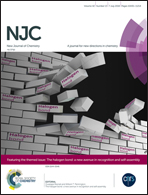Design and development of novel antibiotics based on FtsZ inhibition – in silico studies†
Abstract
Current clinical therapeutics for the treatment of drug-resistant bacteria are mostly restricted to β-lactam antibiotics in combination with β-lactamase inhibitors. However, with the occurrence of novel pathogens, this strategy has proven to be insufficient; therefore, novel approaches for the treatment of infections must be applied. Filamentous temperature-sensitive protein Z (FtsZ) is one of the appealing targets for the design of antimicrobial therapeutics. The present study aims to develop QSAR models for a series of 3-substituted benzamide derivatives as FtsZ inhibitors. The QSAR models were calculated on the basis of optimal molecular descriptors based on the SMILES notation with the Monte Carlo method as a model developer. The statistical quality of the developed model, including robustness and predictability, was good, and it was tested with different methods. Molecular fragments responsible for the increases and decreases of the studied activity were defined. The computer-aided design of new compounds as potential FtsZ inhibitors was presented. The molecular docking study was used for the final assessment of the developed QSAR model and designed novel inhibitors, and the obtained results were in excellent correlation with the results from QSAR studies. The presented study can be useful in the search for novel antibacterial agents based on FtsZ inhibition.



 Please wait while we load your content...
Please wait while we load your content...